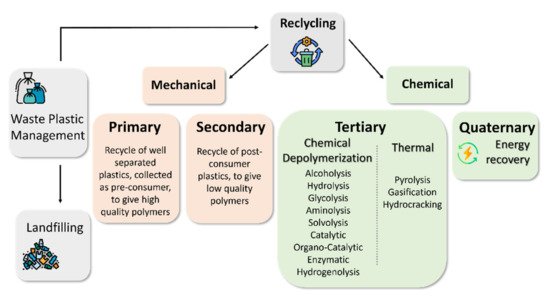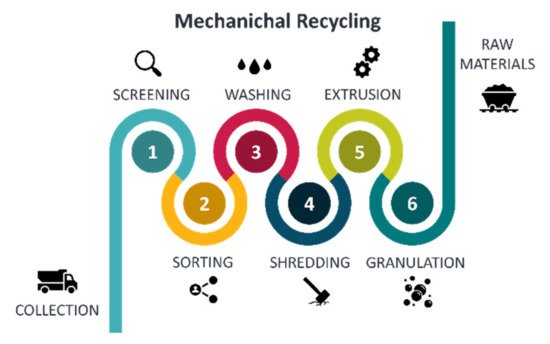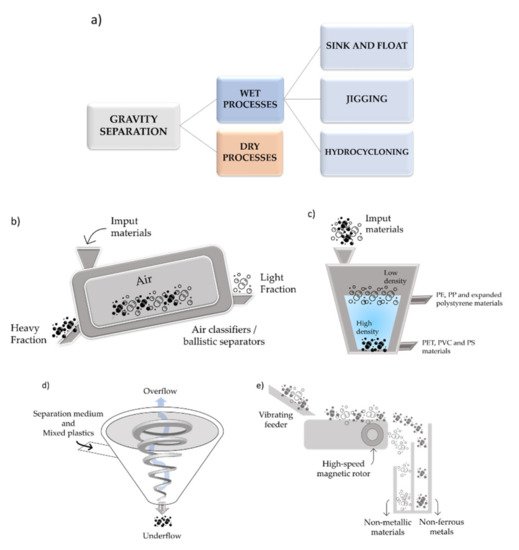1. Introduction
In recent years, the health of our planet has become a problem of crucial importance, with plastic recovery and disposal being of primary relevance
[1].
Since the introduction of Bakelite in 1907 by Leo H. Baekeland, the first fully synthetic polymer, the plastic industry has evolved to revolutionize the way we live
[2][3][4][5].
Polymers and plastic products own their well-known ubiquity and massive use to their excellent chemical–physical properties, which guarantee light weight, low price, and endurance
[6]. Thanks to their great versatility, plastics are among the most used materials and find applications in many industrial sectors such as packaging, automotive vehicles, construction, and electronic devices
[1][7][8].
2. Overview of Plastic Recycling Techniques
The word recycling refers to a set of modifications and transformations (mechanical treatment, chemical treatment, or heating) required to recover feedstock from a previously processed polymer which can be reused by the industry
[9][10][11]. Plastic recycling methods available today are classified in primary to quaternary processes
[12][13] (
Scheme 1).
Scheme 1. Overview of plastic recycling techniques.
Specifically, primary processes allow recovering and recycling pre-consumer or pure polymers which can be reused for the same scope. Secondary processes start from recovered post-consumer polymeric waste, which is sorted, trimmed, and re-extruded, giving a product with reduced physical–mechanical characteristics compared to the starting polymer, which in most cases cannot be reused for the same scope. Primary and secondary recycling represents physical processes that can be repeated several times. Tertiary processes adopt chemical recycling starting from polymers which may no longer undergo mechanical recycling, while quaternary ones are used for energy production. Polymers and plastics sent to landfill (end-of-life plastics) lose their value and become waste.
Different techniques adopted for plastic waste separation, processing, and possible reuse as secondary materials depend on the type of waste recovered. A first important distinction should be made between thermoplastic and thermoset polymers. Thermoplastics are usually processed by extrusion, as these polymers melt when heated and harden when cooled. A great advantage of thermoplastics is that the extrusion process can be repeated many times. The most used thermoplastics are PP, PET, LDPE, HDPE, PVC, and PS. Adversely, thermosets may not be reprocessed by extrusion since, when heated, an irreversible chemical reaction takes place. Main thermoset plastics are polyurethanes (PUR), resins (epoxy, phenol-formaldehyde, and polyester), and vulcanized rubber, widely used by the automotive and electronic industry. The most abundant polymers in post-consumer waste are polyolefins (PP, LDPE, HDPE, PET, and PS) used for packaging
[14][15][16], with a consumption of over 23 Mt only in the EU in 2020.
3. Primary and Secondary Recycling
Mechanical recycling is the main and most widely used technology for plastic recycling, consisting of several steps, including collection, screening, automatic or manual sorting, washing, shredding, extrusion, and granulation
[17][18][19][20] (
Scheme 2). Mechanical recycling is classified as primary or secondary according to the type of starting material being processed. Primary recycling gives the highest-quality recycled polymers and starts from closed-loop recycled products such as PET bottles or byproducts collected by manufacturing industries as pre-consumer well-separated material.
Scheme 2. General scheme of primary and secondary recycling processes.
Secondary processes instead recover post-consumer plastics and, therefore, generate lower-quality polymers. It must nevertheless be considered that, from an economic standpoint, these processes have a reduced complexity and overall limited costs, generating significant income and reduced CO
2 production. According to the Ellen MacArthur foundation report, plastic production and incineration of plastic waste are estimated to produce over 400 Mt of CO
2 yearly
[21][22]. Thus, recycled plastics can reduce fossil-fuel consumption and CO
2 emissions. According to estimates by Rahimi and coworkers
[23], the adoption of plastic waste recycling worldwide would allow saving about 3.5 million barrels of oil each year.
Mechanical recycling generally includes four main steps: (i) screening and sorting; (ii) shredding; (iii) washing and drying; (iv) melting and reprocessing (
Scheme 2).
Screening and sorting of plastic waste is a fundamental step for the recyclability of the different plastics and the quality of the final polymer. This step is challenging, considering that the separation of mixed plastic waste often involves the combined use of different technologies
[24][25].
To achieve an adequate separation of a specific polymer within a flow stream containing many different components (plastics, as well as metals, paper, organic residues, and dirt), characteristics of the final product must be accurately considered such as purity and destination. This will allow defining the best separation strategy to achieve high selection. Important properties commonly employed for plastic separation are magnetic or electric properties, particle size, density, and color. Relying on these properties, many different separation techniques have been developed such as dry or wet gravity separation, electronic or magnetic density separation, flotation, and sensor-based sorting together with auxiliary segregation techniques such as magnetic or eddy-current separation. These segregation methods are briefly described, mainly focusing on recently implemented technologies for PE, PP, PET, and PS recovery.
Gravity separation is a consolidated methodology that may be carried out in a dry environment (dry process) or in the presence of water (wet process)
[26][27] (
Figure 1a). Dry segregation techniques employ air classifiers or ballistic separators in which air is used as the medium to separate lighter materials from heavier ones. They can be positioned at the beginning of the process or at the end, to segregate end-of-life plastics from main plastic streams (
Figure 1b). Wet gravity separation includes sink and float, jigging, and hydrocyclone techniques.
Figure 1. (a) Different methodologies of gravity separation; (b) dry segregation; (c) sink and float separation; (d) hydrocycloning; (e) eddy current separator.
With sink and float separation, polymers are separated into two different streams depending on whether they have a higher or lower density than water. Materials such as PET, PVC, and PS will sink, while others such as PE, PP, and expanded polystyrene will float (
Figure 1c). This type of separation guarantees an effective first separation, but it is not adequate to produce high-quality secondary materials and needs to be combined with other separation techniques
[28][29][30].
Zhang and coworkers developed a pretreatment of PET via preliminary NaOH and ethanol hydrolysis to promote plastic flotation. Optimal conditions allowed the quantitative recovery of highly pure PET fractions
[31].
Heidarpour and coworkers reported the influence of microwave irradiation in the presence of chemical additives such as PEG-400, methylcellulose, or tannic acid on the float–sink behavior of polyoxymethylene, polycarbonate, and polyvinyl alcohol. According to this study, microwave irradiation reduced the contact angle values of tested plastic surface in the presence of chemical additives (depressant) by implementing their sink–float separation capacity, thereby increasing their hydrophilicity
[32]. The authors mention the possibility of using this technology for whichever plastic material.
Jigging is one of the oldest gravity separation techniques and is similar to dry gravity methods where, in most cases, water is used instead of air
[24][29]. A water stream is pushed up and down by pistons, and plastics are separated mainly depending on their morphological and physical characteristics.
Hydrocycloning is based on centrifugal and centripetal forces together with the fluid resistance of different materials processed (
Figure 1d). New trends in hydrocycloning separation focus especially on the recovery of precious metals from electronic device waste
[33][34], and it seems to be a very valuable tool for more sustainable separation of plastic waste from metals.
The eddy current separator is made of a high-speed magnetic rotor which generates an electric current, the so-called eddy current, used to remove nonferrous metals (aluminum and copper) from waste plastic, glass, and paper, among others (
Figure 1e)
[35]. These separators are generally located at the beginning of the recycling process.
With a separator and drum screen, plastics are fed into a large rotating drum where materials are separated by size, thanks to holes in the drum, so that only smaller particles pass through and are separated from larger ones.
Different gravity segregation methods were analyzed by Nie and coworkers for the sustainable recovery and recycling of high-value metals from waste printed circuit board (WPCBs)
[36]. This study analyzed the dynamics and statics of gravity concentration methods. The settling velocity of three kind of particles was studied, demonstrating that the stratification by density is spontaneous and can achieve the lowest potential energy. The concentration of differently sized metal particles could be effectively enriched, and the metal purity increased from 56.5% to 68.2% for decreasing particle size, albeit with a modest decrease in yield (from 86.41% to 83.04%). No recent papers were found for the use of innovative solutions for the recovery of PE, PP, PET, or PS by jigging, hydrocycloning, eddy current separation, and drum and different gravity segregation techniques, but they were reported to give a general overview of different separation technologies available.
Optical sensors are used for the characterization of plastic stream in a continuous manner where air jets allow for separation. Optical sensors may be subdivided in molecular spectroscopies and atomic spectroscopies
[37], the prevalently used Raman spectroscopy (RS)
[38], Fourier-transform infrared spectroscopy (FTIR)
[31], near-infrared spectroscopy (NIRS)
[39], and terahertz spectroscopy (THz)
[40], and elemental spectroscopies such as laser-induced breakdown spectroscopy (LIBS)
[41] and X-ray fluorescence spectroscopy (XRFS)
[37].
Bobulski and coworkers implemented new portable devices for computer image recognition in combination with artificial intelligence for waste recognition and easy municipal waste separation. The devices were used both at home and in waste sorting plants, and they could be a very useful tool for an efficient and economically sustainable separation of plastic waste stream
[42].
Most companies use a combination of different separation techniques to obtain sufficiently pure polymers from post-consumer plastic waste. The purity of the finished product depends on an adequate compromise between costs and benefits, and this leads to purities ≤95% which require further separation and purification steps. Sorting technologies reported above are generally inadequate for the separation of complex materials such as multilayered packaging or fiber-reinforced composites; therefore, these materials are generally incinerated for energy recovery or landfilled as end-of-life plastics.
Innovative recycling methods such as selective polymer dissolution were demonstrated to be efficient in extracting different polymers and fibers from multilayered films and composite materials
[43]. In fact, Knappich and coworkers reported the efficient recovery and recyclability of epoxy and polyurethane resins from carbon fiber-reinforced plastics with different proprietary CreaSolv
® formulations at a laboratory scale.
Multi-material plastic waste separation technologies are also being developed to enable a proper sorting of composites, which will generate new value streams to recover and recycle plastics which are today incinerated or landfilled
[44]. Many approaches have been tested, for example, for the separation of polyester from cotton fibers to recycle textile waste. Solvent-based technologies are an interesting solution, with the possibility of selecting specific solvents which may solubilize either cotton or polyesters
[45]. A crucial aspect for industrial success and applicability is the nature of the solvent in terms of volatility, flammability, toxicity, and recyclability
[46].
Once the mechanical separation is complete, the materials are shredded by passing them through a system of rotating blades. The obtained flakes are then sorted by size with a grid, washed and dried, made ready for reprocessing by extrusion or agglomeration, and sold.
Agglomeration is generally used to reprocess plastic films which are cut in small pieces, heated by friction and water-cooled. The agglomerates are usually combined into plastic flakes and pelletized by extrusion. Agglomeration is highly energy-consuming and, therefore, less widespread
[24].
Extrusion remains the most widely used method for processing both virgin and recycled plastic. Plastic flakes are fed into the extruder and pushed by a screw into a heated cylinder, thus melting the plastic. At the end of the extruder, a pelletizer cools and cuts the final polymer into pellets.
Both shredding and extrusion may lead to partial degradation of the polymer due to chain scission and thermo-oxidative reactions, reducing the polymer chain length and, consequently, its mechanical properties
[47][48]. Moreover, impurities deriving from other packaging components further contribute to the diminished physical–mechanical characteristics of reprocessed plastics
[39].
A detailed study was published by Eriksen and coworkers on the thermal degradation, processability, and mechanical properties of re-extruded PET, PE, and PP from post-consumer waste. PET is well suited for closed-loop recycling to meet bottle and food-grade PET quality, although moisture control is a key requirement when reprocessing PET into products. For this polymer, degradation, which generally occurs during recycling by extrusion, may be avoided by careful decontamination. The quality of reprocessed PE samples from non-food bottles strongly depends on the presence of impurities from other polymers and from lids and labels. PE reprocessing by extrusion suggested that closed-loop recycling may be achieved with selected PE bags with low levels of polymer cross-contamination. Adversely, PP reprocessed by extrusion showed low mechanical properties with large variations in impact strength, reducing possible applications of reprocessed PP. Thus, the heterogeneity of PP waste, even if food packaging is managed separately, as well as polymer degradation during recycling, represents crucial limitations for PP waste recycling
[49].
A possible remedy to downgrading due to extrusion was reported for the first time by Wang and coworkers. The authors reported a process to modify polyolefins from post-consumer plastic waste via a one-step radical grafting and cross-linking process, producing covalent adaptable networks or CANs
[47]. This procedure relies on the functionalization of polyolefins with polar reagents, which modify the properties of the starting material, thus imparting new characteristics such as wettability, printability, and compatibility with other polymers. Upcycling of LDPE from plastic bags was achieved by free-radical reaction in a twin-screw extruder in the presence of maleic anhydride and butanediol. PE-CANs showed higher solvent resistance, tensile strength, and modulus compared to virgin PE due to the presence of cross-linking bonds generated during the extrusion process. Upcycling of post-consumer plastic waste by reactive extrusion is an interesting area of research which will surely receive much attention in the future; however, characteristics of CAN polymers must be acquired to define new possible manufacturing applications
[50].



